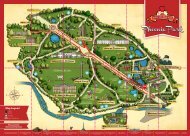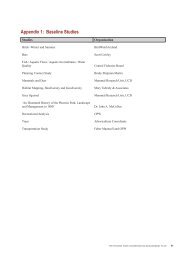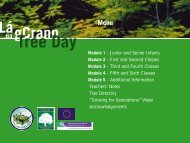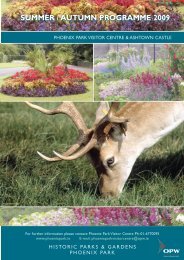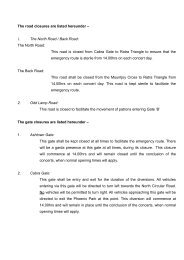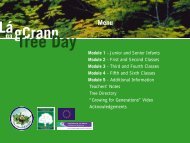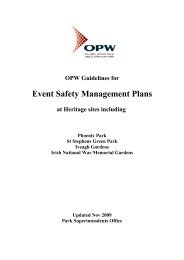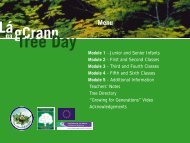The Birds of the Phoenix Park, County Dublin: Results of a survey in ...
The Birds of the Phoenix Park, County Dublin: Results of a survey in ...
The Birds of the Phoenix Park, County Dublin: Results of a survey in ...
You also want an ePaper? Increase the reach of your titles
YUMPU automatically turns print PDFs into web optimized ePapers that Google loves.
Rema<strong>in</strong><strong>in</strong>g Amber-listed species consisted mostly <strong>of</strong> waterbirds:<br />
• Breed<strong>in</strong>g Little Grebe, Cormorant, Teal, Common Gull, Lesser Black-backed Gull and Great Blackbacked<br />
Gull have suffered decl<strong>in</strong>es <strong>in</strong> numbers and/ or range, and/ or have relatively localised<br />
ranges.<br />
• W<strong>in</strong>ter<strong>in</strong>g Wigeon and Tufted Duck are relatively localised, and Tufted Duck is an EU SPEC 3<br />
species. Mute Swan is Amber-listed on <strong>the</strong> basis that at least 20% <strong>of</strong> <strong>the</strong> non-breed<strong>in</strong>g population<br />
occurs <strong>in</strong> Ireland. This population is considered to be resident.<br />
• Both breed<strong>in</strong>g and non-breed<strong>in</strong>g Pochard and Coot are Amber-listed; both are SPEC 2 species, and<br />
<strong>the</strong>reby qualify, while Pochard is a breed<strong>in</strong>g rarity, and is relatively localised dur<strong>in</strong>g <strong>the</strong> nonbreed<strong>in</strong>g<br />
period, and Coot has suffered a decl<strong>in</strong>e <strong>in</strong> breed<strong>in</strong>g range, and is also localised dur<strong>in</strong>g <strong>the</strong><br />
non-breed<strong>in</strong>g period.<br />
• Snipe is an EU SPEC 3 species, and <strong>the</strong>reby qualifies as Amber-listed.<br />
All o<strong>the</strong>r Amber-listed species present <strong>in</strong> <strong>the</strong> park are listed as EU SPEC 3, with <strong>the</strong> exception <strong>of</strong> L<strong>in</strong>net,<br />
which is SPEC 2, and Stock Dove, which is not <strong>of</strong> European conservation concern, but whose numbers have<br />
decl<strong>in</strong>ed substantially over <strong>the</strong> past 50 years (Lynas et al. 2007).<br />
Recommendations for enhanc<strong>in</strong>g bird diversity<br />
<strong>The</strong>re are many ways <strong>in</strong> which urban green spaces can be managed while enhanc<strong>in</strong>g biodiversity. <strong>The</strong><br />
follow<strong>in</strong>g recommendations may be possible for some areas <strong>of</strong> <strong>the</strong> park:<br />
• Adopt a long-term policy on tree-plant<strong>in</strong>g us<strong>in</strong>g a variety <strong>of</strong> native species, and avoid<strong>in</strong>g even-age<br />
plant<strong>in</strong>g. This would be best done away from formal avenues <strong>of</strong> trees.<br />
• Ivy allowed to grow on some trunks provides additional nest sites, and food (berries) dur<strong>in</strong>g later<br />
w<strong>in</strong>ter when o<strong>the</strong>r berries are depleted. It also supports <strong>in</strong>vertebrate prey. Fallen trees, branches and<br />
leaf-litter if left, also support <strong>in</strong>vertebrate communities, fungi and o<strong>the</strong>r taxa.<br />
• Erect deer exclosures <strong>in</strong> some woodland areas to encourage natural regeneration <strong>of</strong> trees and <strong>the</strong><br />
development <strong>of</strong> a well-structured and diverse understorey.<br />
• <strong>The</strong>re were relatively few areas <strong>of</strong> scrub around <strong>the</strong> park. A good mix <strong>of</strong> short to tall scrub is <strong>of</strong><br />
benefit to nest<strong>in</strong>g birds. Plant<strong>in</strong>g <strong>of</strong> native Hawthorn and Blackthorn is encouraged, as <strong>the</strong>se are rich<br />
<strong>in</strong> <strong>in</strong>vertebrates and provide berries later <strong>in</strong> <strong>the</strong> year.<br />
• When cutt<strong>in</strong>g back scrub and shrubs, try not to cut all patches <strong>in</strong> <strong>the</strong> same year, that way a range <strong>of</strong><br />
growth stages will be available. Avoid any radical management actions dur<strong>in</strong>g <strong>the</strong> breed<strong>in</strong>g period<br />
(March – September).<br />
• Areas <strong>of</strong> longer more rank grass are valuable habitats to wildlife. A strip <strong>of</strong> longer grass around<br />
shorter mown grass, and preferably border<strong>in</strong>g o<strong>the</strong>r natural habitats such as trees and/or shrubs, cut<br />
just once or twice a year, could assist <strong>in</strong> <strong>in</strong>creas<strong>in</strong>g <strong>the</strong> numbers <strong>of</strong> flowers and <strong>in</strong>sects.<br />
• An additional zone <strong>of</strong> rank vegetation cut <strong>in</strong> alternate years would encourage larger seed<strong>in</strong>g plants,<br />
and provide food and shelter for nest<strong>in</strong>g birds. Areas <strong>of</strong> longer grass should not be mown dur<strong>in</strong>g <strong>the</strong><br />
breed<strong>in</strong>g period, as <strong>the</strong>re may be ground-nest<strong>in</strong>g birds present.<br />
• M<strong>in</strong>imise <strong>the</strong> use <strong>of</strong> pesticides, herbicides and artificial fertilizer as much as possible, at least <strong>in</strong><br />
some areas <strong>of</strong> <strong>the</strong> park.<br />
• Plant<strong>in</strong>g <strong>of</strong> wildflower meadows and o<strong>the</strong>r crops would allow birds to feed on a huge ‘bird table’ <strong>of</strong><br />
seeds, especially dur<strong>in</strong>g <strong>the</strong> w<strong>in</strong>ter months. Crops, such as L<strong>in</strong>seed, provide a huge resource for birds<br />
and attract large flocks <strong>of</strong> seed-eat<strong>in</strong>g species such as Greenf<strong>in</strong>ch, L<strong>in</strong>net, Chaff<strong>in</strong>ch, Goldf<strong>in</strong>ch and<br />
Redpoll.<br />
• Create more ponds and small lakes around <strong>the</strong> park.<br />
• Swallows and House Mart<strong>in</strong>s may choose to nest under eaves. Starl<strong>in</strong>gs and Swifts may nest <strong>in</strong> <strong>the</strong><br />
ro<strong>of</strong> itself. House Sparrows can be encouraged away from ro<strong>of</strong> spaces by provid<strong>in</strong>g nest boxes<br />
attached to a wall, especially if near a climb<strong>in</strong>g plant.<br />
13




